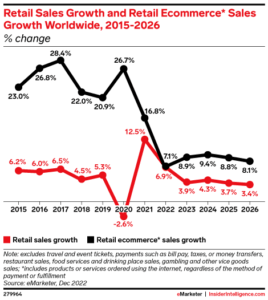The e-commerce phenomenon has been nothing short of miraculous. It has transformed the way businesses operate and consumers interact with merchants. From the humble beginnings of the first e-commerce transaction in 1994 to the billion-dollar industry it is today, e-commerce has come a long way in a very short time. Let’s take a look at the past, present, and future of e-commerce and how it has changed the way we shop and do business.
Celebrating a Success Story: E-commerce Booming
The rise of e-commerce has been a powerful force in reshaping the retail landscape. It has enabled businesses to reach more customers and offer more products and services than ever before. In 2020, e-commerce sales accounted for 14.3% of all global retail sales, a figure that is expected to reach 20.5% by 2023. The pandemic has only accelerated this growth, as more people than ever before are now shopping online.
The success of e-commerce has also been a boon to small businesses. Even the smallest business owners can now have a digital presence that allows them to reach new markets and capture the attention of potential customers in the digital space.
With the right tools and marketing tactics, even the smallest businesses are able to compete with larger players in the e-commerce space.
Lastly, the advances in technology have enabled e-commerce businesses to offer a more personalized and tailored shopping experience to their customers.
Through artificial intelligence and machine learning, e-commerce businesses are able to provide a more personalized shopping experience to customers with tailored product recommendations, targeted promotions, and more.
Glimpsing a Bright Future of Online Commerce

The future of e-commerce looks bright. As the demand for online shopping continues to grow, businesses will look for new and innovative ways to keep customers engaged. One such way is through the use of virtual and augmented reality, which can provide customers with a more immersive shopping experience.
In addition, e-commerce businesses are also looking to capitalize on the potential of social media.
Social media can be used to reach more customers, build relationships, and create more personalized and targeted marketing campaigns. Social media also provides businesses with an opportunity to create a sense of community and loyalty among their customers.
Lastly, the use of blockchain technology will also be an important factor in the future of e-commerce. Blockchain technology can be used to create a secure, transparent, and efficient transaction process which will help to reduce costs and enable businesses to offer more competitive prices.
Blockchain can also be used to protect customers’ data and ensure that their transactions are safe and secure.
In conclusion, e-commerce has come a long way in a very short time. From its humble beginnings to its current success, e-commerce has transformed the way businesses operate and consumers shop. With the use of technology and the potential of social media and blockchain, the future of e-commerce looks to be even brighter and more exciting.
It will be interesting to see where e-commerce takes us in the coming years.

